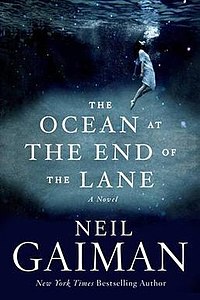
It says much about Neil Gaiman’s writing that
the first night I read 50 pages of his 2013 novel ‘The Ocean at the End Of the
Lane’, I had a nightmare about a half man, half lizard repeatedly attacking me.
No – there isn’t a lizard man in Gaiman’s novel but it certainly has some
creepy characters and a chilling atmosphere. Gaiman is well known for creating
other worlds that are unsettling, particularly in that they are inverting the
concepts of our own world. Much of his work is seen through the eyes of a child
protagonist or narrator, but the novels don’t feel like they are written for
children or young adults. In this best-selling novel, the narrator is unnamed:
a man who has come back to his childhood home for a funeral, and takes us back
with him in time to age seven to remember the strange events that took place.
The narrator lived on a rambling estate with his parents and his younger sister,
who were completely normal. In this Gaiman novel, unlike his other best-seller
Coraline where the parents were monsters, it is the neighbours and his new
nanny who are the unusual element. On a farm next to the narrator’s home, three
females (the Hempstocks) welcome him into their lives: young Lettie, eleven
years old, and two older ladies who appear to be her mother and grandmother. The
Hempstocks are soon revealed to possess strange abilities to transverse space
and time: the narrator is taken into what seems another dimension by holding
Lettie’s hand, and happens to pull back with him the monster of Ursula who
becomes his nanny. Writing a synopsis of the novel makes it seem very simple,
but it’s Gaiman’s imagination, and ability to create unsettling tension that
makes his writing so popular, and evocative. And while the images are
nightmarish, the characters have a quaintness that relieves the reader from the
heavier material. The Hempstocks with their old style, rustic goodness are
beautifully drawn, and the reader is made to feel as safe as the narrator when
in their company. Lettie in particular with her adult wisdom is a charming
character:
“Oh, monsters are scared,"
said Lettie. "That's why they're monsters. And as for grown-ups...' She
stopped talking, rubbed her freckled nose with a finger. Then, 'I'm going to
tell you something important. Grown-ups don't look like grown-ups on the inside
either. Outside, they're big and thoughtless and they always know what they're
doing. Inside, they look just like they always have. Like they did when they
were your age. Truth is, there aren't any grown-ups. Not one, in the whole wide
world.””
Likewise to Lettie’s wise adult
voice, the narrator’s adult-remembering-childhood perspective is melancholic
and insightful: “I do not miss childhood, but I miss the way I took pleasure in
small things, even as greater things crumbled.”
To analyse this short novel any
further would give too much away, but I would recommend dipping into Gaiman’s
imaginary world: beware dreaming of lizard men at your own peril.
No comments:
Post a Comment